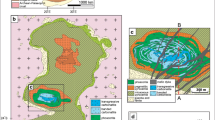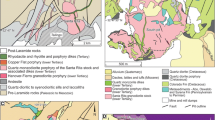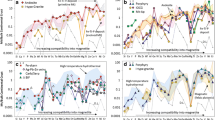Abstract
The El Laco magnetite deposits consist of more than 98 % magnetite but show field textures remarkably similar to mafic lava flows. Therefore, it has long been suggested that they represent a rare example of an effusive Fe oxide liquid. Field and petrographic evidence, however, suggest that the magnetite deposits represent replacement of andesite flows and that the textures are pseudomorphs. We determined the trace element content of magnetite by laser ablation inductively coupled plasma mass spectrometry (LA-ICP-MS) from various settings at El Laco and compared them with magnetite from both igneous and hydrothermal environments. This new technique allows us to place constraints on the conditions under which magnetite in these supposed magnetite “lava flows” formed. The trace element content of magnetite from the massive magnetite samples is different to any known magmatic magnetite, including primary magnetite phenocrysts from the unaltered andesite host rocks at El Laco. Instead, the El Laco magnetite is most similar in composition to hydrothermal magnetite from high-temperature environments (>500 °C), such as iron oxide-copper-gold (IOCG) and porphyry-Cu deposits. The magnetite trace elements from massive magnetite are characterised by (1) depletion in elements considered relatively immobile in hydrothermal fluids (e.g. Ti, Al, Cr, Zr, Hf and Sc); (2) enrichment in elements that are highly incompatible with magmatic magnetite (rare earth elements (REE), Si, Ca, Na and P) and normally present in very low abundance in magmatic magnetite; (3) high Ni/Cr ratios which are typical of magnetite from hydrothermal environments; and (4) oscillatory zoning of Si, Ca, Mg, REE and most high field strength elements, and zoning truncations indicating dissolution, similar to that formed in hydrothermal Fe skarn deposits. In addition, secondary magnetite in altered, brecciated host rock, forming disseminations and veins, has the same composition as magnetite from the massive lenses. Euhedral magnetite lining both open-spaced veins in the brecciated host rock and along the walls of large, hollow chimneys in the massive magnetite lenses also displays oscillatory zoning and most likely formed by fluctuating composition and/or physio-chemical conditions of the fluid. Thus, the chemical fingerprint of magnetite from the supposed El Laco magnetite lava flows supports the hydrothermal model of metasomatic replacement of andesite lava flows, by dissolution and precipitation of magnetite from high-temperature fluids, rather than a magmatic origin from an effusive Fe oxide liquid.







Similar content being viewed by others
References
Angerer T, Hagemann SG, Danyushevsky L (2013) High-grade iron ore at Windarling, Yilgarn Craton: a product of syn-orogenic deformation, hypogene hydrothermal alteration and supergene modification in an Archean BIF-basalt lithostratigraphy. Mineral Deposita 48:697–728
Barton MD, Johnson DA (1996) Evaporitic-source model for igneous-related Fe oxide–(REE-Cu-Au-U) mineralization. Geology 24:259–262
Boutroy E, Dare SAS, Beaudoin G, Barnes S-J, Lightfoot PC (2014) Magnetite composition in Ni-Cu-PGE deposits worldwide and its application to mineral exploration. J Geochem Explor 145:64–81
Broman C, Nyström JO, Henríquez F, Elfman M (1999) Fluid inclusions in magnetite-apatite ore from a cooling magmatic system at El Laco, Chile. GFF 121:253–267
Chen WT, Zhou M-F, Zhao T-P (2013) Differentiation of nelsonitic magmas in the formation of the ~1.74 Ga Damiao Fe–Ti–P ore deposit, North China. Contrib Mineral Petrol 165:1341–1362
Clark AH, Kontak DJ (2004) Fe-Ti-P oxide melts generated through magma mixing in the Antauta subvolcanic center, Peru: implications for the origin of nelsonite and iron oxide-dominated hydrothermal deposits. Econ Geol 99:377–395
Corriveau L, Williams PJ, Mumin AH (2010) Alteration vectors to IOCG mineralization from uncharted terrains to deposits. In: Corriveau L, Mumin AH (eds) Exploring for iron oxide copper gold deposits: Canada and global analogues. The Geological Association of Canada, St. John’s, pp 89–110
Dare SAS, Barnes S-J, Beaudoin G (2012) Variation in trace element content of magnetite crystallized from a fractionating sulfide liquid, Sudbury, Canada: implications for provenance discrimination. Geochim Cosmochim Acta 88:27–50
Dare SAS, Barnes S-J, Beaudoin G, Méric J, Boutroy E, Potvin-Doucet C (2014) Trace elements in magnetite as petrogenetic indicators. Miner Depos 49:785-796
Dupuis C, Beaudoin G (2011) Discriminant diagrams for iron oxide trace element fingerprinting of mineral deposit types. Mineral Deposita 46:319–335
Frietsch R, Perdahl J-A (1995) Rare earth elements in apatite and magnetite in Kiruna-type iron ores and some other iron ore types. Ore Geol Rev 9:489–510
Harrison TM, Watson EB (1984) The behavior of apatite during crustal anatexis: equilibrium and kinetic considerations. Geochim Cosmochim Acta 48:1467–1477
Hildebrand RS (1986) Kiruna-type deposits; their origin and relationship to intermediate subvolcanic plutons in the Great Bear magmatic zone, Northwest Canada. Econ Geol 81:640–659
Hu H, Li J-W, Lentz D, Ren Z, Zhao X-F, Deng X-D, Hall D (2014) Dissolution–reprecipitation process of magnetite from the Chengchao iron deposit: insights into ore genesis and implication for in-situ chemical analysis of magnetite. Ore Geol Rev 57:393–405
Jonsson E, Troll VR, Högdahl K, Harris C, Weis F, Nilsson KP, Skelton A (2013) Magmatic origin of giant ‘Kiruna-type’ apatite-iron-oxide ores in Central Sweden. Scientific reports 3
Lester G, Clark A, Kyser T, Naslund H (2013) Experiments on liquid immiscibility in silicate melts with H2O, P, S, F and Cl: implications for natural magmas. Contrib Mineral Petrol 166:329–349
Lodders K (2003) Solar system abundances and condensation temperatures of the elements. Astrophys J 591:1220
Mitsis I, Economou-Eliopoulos M (2001) Occurrence of apatite associated with magnetite in an ophiolite complex (Othrys), Greece. Am Mineral 86:1143–1150
Nadoll P, Mauk JL, Hayes TS, Koenig AE, Box SE (2012) Geochemistry of magnetite from hydrothermal ore deposits and host rocks of the Mesoproterozoic Belt Supergroup, United States. Econ Geol 107:1275–1292
Nadoll P, Angerer T, Mauk JL, French D, Walshe J (2014) The chemistry of hydrothermal magnetite: a review. Ore Geol Rev 61:1–32
Naranjo JA, Henríquez F, Nyström JO (2010) Subvolcanic contact metasomatism at El Laco Volcanic Complex, Central Andes. Andean Geol 37:110–120
Naslund H, Henríquez F, Nyström J, Vivallo W, Dobbs F (2002) Magmatic iron ores and associated mineralization: examples from the Chilean High Andes and Coastal Cordillera. Hydrothermal Iron Oxide Copper-Gold Relat Depos: Glob Perspect 2:207–226
Nyström J, Henríquez F (1994) Magmatic features of iron ores of the Kiruna type in Chile and Sweden: ore textures and magnetite geochemistry. Econ Geol 89:820–839
Park CF (1961) A magnetite “flow” in northern Chile. Econ Geol 56:431–441
Rhodes A, Oreskes N (1999) Oxygen isotope composition of magnetite deposits at El Laco, Chile: evidence of formation from isotopically heavy fluids. Soc Econ Geol Spec Publ 7:333–351
Rhodes AL, Oreskes N, Sheets S (1999) Geology and rare earth element geochemistry of magnetite deposits at El Laco, Chile. Soc Econ Geol Spec Publ 7:299–332
Rudnick R, Gao S (2003) Composition of the continental crust. Treatise Geochem 3:1–64
Sheets S, Oreskes N, Rhodes A, Bodnar R, Szabo C (1997) Fluid inclusion evidence for a hydrothermal origin for magnetite-apatite mineralization at El Laco, Chile. Geological Society of America, Abstracts with Programs. pp A50
Shimazaki H (1998) On the occurrence of silician magnetites. Resour Geol 48:23–29
Sillitoe RH, Burrows DR (2002) New field evidence bearing on the origin of the El Laco magnetite deposit, northern Chile. Econ Geol 97:1101–1109
Sillitoe RH, Burrows DR (2003) New field evidence bearing on the origin of the El Laco magnetite deposit, northern Chile—a reply. Econ Geol 98:1501–1502
Tollari N, Baker D, Barnes S-J (2008) Experimental effects of pressure and fluorine on apatite saturation in mafic magmas, with reference to layered intrusions and massif anorthosites. Contrib Mineral Petrol 156:161–175
Toplis MJ, Libourel G, Carroll MR (1994) The role of phosphorus in crystallisation processes of basalt: an experimental study. Geochim Cosmochim Acta 58:797–810
Tornos F, Velasco F, Morata D, Barra F, Rojo M (2011) The magmatic-hydrothermal evolution of the El Laco as tracked by melt inclusions and isotope data In: Barra F, Reich M, F T (eds) Proceedings of the 11th Biennial SGA Meeting. Antofagasta, Chile, pp 443–445.
Velasco F, Tornos F (2012) Insights on the effects of hydrothermal alteration in the El Laco magnetite deposit. Macla 16:210–211
Weidner JR (1982) Iron-oxide magmas in the system Fe-C-O. Can Mineral 20:555–566
Zhou M-F, Chen WT, Wang CY, Prevec SA, Liu PP, Howarth GH (2013) Two stages of immiscible liquid separation in the formation of Panzhihua-type Fe-Ti-V oxide deposits, SW China. Geosci Front 4:481–502
Acknowledgments
This project was funded by NSERC, DIVEX, Vale, the Canadian Research Chair in Magmatic Metallogeny, and in part by the Geological Survey of Canada’s TGI4 program. We thank S. Medhi, D. Savard and M. Choquette for their assistance with laser ablation-ICP-MS and microprobe analyses, respectively. We thank SGA Chilean guides and D. Genna for their aid with sample collection and photos. Thanks are given to F. Tornos and L. Fontboté for additional samples from El Laco and to H. Mumin, L. Corriveau, J. Richards and D. Naslund for interesting and stimulating discussions. We are very grateful to comments from 3 reviewers (D. Burrows, D. Naslund and 1 anonymous) and Editor, B. Lehmann.
Author information
Authors and Affiliations
Corresponding author
Additional information
Editorial handling: B. Lehmann
Electronic supplementary material
Below is the link to the electronic supplementary material.
ESM 1
(XLS 232 kb)
Rights and permissions
About this article
Cite this article
Dare, S.A.S., Barnes, SJ. & Beaudoin, G. Did the massive magnetite “lava flows” of El Laco (Chile) form by magmatic or hydrothermal processes? New constraints from magnetite composition by LA-ICP-MS. Miner Deposita 50, 607–617 (2015). https://doi.org/10.1007/s00126-014-0560-1
Received:
Accepted:
Published:
Issue Date:
DOI: https://doi.org/10.1007/s00126-014-0560-1




